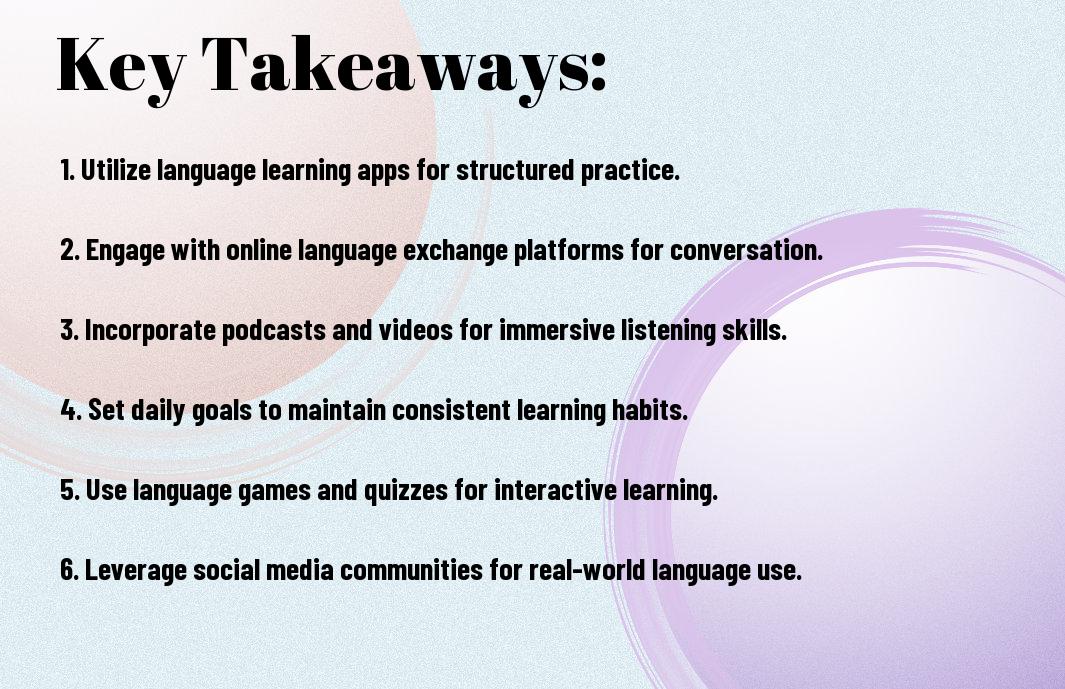You are about to launch on a journey to learn a new language, and your tool of choice is technology. With numerous digital resources at your fingertips, you can access language lessons, interactive exercises, and native speaker exchanges. Your path to language proficiency will be streamlined, and you will be able to track your progress. In this article, you will discover how to harness the power of technology to achieve your language learning goals, and make the most of your time and effort.
Key Takeaways:
- Utilize Language Learning Apps such as Duolingo, Babbel, and Rosetta Stone to access a wide range of interactive lessons and exercises that cater to different learning styles and levels.
- Leverage Online Courses and tutorials on platforms like Coursera, Udemy, and edX to learn from experienced instructors and gain a deeper understanding of language fundamentals and nuances.
- Take advantage of Podcast and Audiobooks to improve listening skills and get exposed to native speakers’ accents, intonations, and conversations.
- Practice Conversation Exchange with native speakers through online communities, social media, and language exchange websites to enhance speaking and writing skills in a realistic and interactive way.
- Use Flashcard and Vocabulary Building tools to expand vocabulary, memorize new words, and develop a stronger grasp of language syntax and grammar rules.
Setting Up Your Language Learning Environment
To begin your language learning journey, you will need to set up an environment that fosters productivity and focus. This includes gathering the necessary tools and resources to help you stay on track.
Choosing the Right Language Learning Apps
Before selecting a language learning app, you should consider your learning style and goals, as this will help you choose the most suitable option for your needs, allowing you to make the most of your study time.
Creating a Productive Study Space
Aiding your ability to focus, a dedicated study space can greatly impact your learning experience, helping you to minimize distractions and stay motivated as you work towards your goals.
The key to creating a productive study space is to tailor it to your individual needs, taking into account your learning style and the resources you require. You should consider the lighting, seating, and noise level, as well as the availability of necessary materials, such as a dictionary or grammar guide, to ensure that you have everything you need to make progress in your language learning journey.

Language Learning Essentials
If you’re serious about learning a language using technology, you’ll need to focus on the fundamentals. Your journey begins with understanding the language’s basics, including grammar and vocabulary. You can use online resources to streamline your learning process and make it more efficient.
Grammar and Vocabulary Building
Upon starting your language learning journey, you’ll find that online tools can help you build a strong foundation in grammar and vocabulary. You can access various websites and apps that offer interactive lessons and exercises tailored to your level and needs.
Pronunciation Practice
Alongside grammar and vocabulary, you’ll need to work on your pronunciation. You can use audio and video recordings to improve your speaking skills, mimicking native speakers and getting feedback on your progress.
This aspect of language learning is where technology truly shines, as you can practice your pronunciation at your own pace, whenever and wherever you want. You can listen to and repeat phrases, record yourself, and compare your pronunciation to that of native speakers, helping you to identify and correct any mistakes, ultimately leading to more effective communication in your target language.
Immersive Language Learning
Now, you can surround yourself with the language you want to learn, using various digital tools and resources. This approach helps you pick up the language naturally, as if you were living in a country where it is spoken.
Watching TV Shows and Movies in the Target Language
Between episodes of your favorite TV show, you can learn new vocabulary and get used to the sound and structure of the language. You can watch TV shows and movies in the target language with subtitles, which will help you understand the dialogue and follow the plot.
Listening to Music and Podcasts
Immersive audio materials like music and podcasts can be an enjoyable way to learn a language. You can listen to your favorite songs or find new ones in the target language, and tune in to podcasts on topics that interest you.
Even more effectively, you can use language learning apps that provide transcripts and translations of the podcasts and songs, allowing you to follow along and look up unfamiliar words. This way, you can improve your listening skills and learn new vocabulary in a engaging and interactive way.

Interactive Language Learning
Unlike traditional learning methods, interactive language learning engages you with immersive experiences, making the process more enjoyable and effective.
Language Exchange Websites and Apps
Prior to submerging into language exchange, you’ll find numerous websites and apps that connect you with native speakers, allowing you to practice your language skills in a conversational setting.
Online Language Communities
Along with language exchange, online language communities provide you with a platform to interact with fellow learners, share resources, and get feedback on your progress.
Above all, online language communities offer you a sense of belonging, motivating you to stay committed to your language learning journey, as you navigate through various discussions, share your goals, and learn from others who are undertaking similar challenges.
Tracking Progress and Staying Motivated
Despite the challenges you may face, tracking your progress is crucial to staying motivated. You can use language learning apps to monitor your progress, identify areas for improvement, and adjust your study plan accordingly.
Setting Achievable Goals and Rewards
With a clear plan in place, you can set achievable goals and rewards for yourself, helping you stay focused and motivated throughout your language learning journey. You can reward yourself for reaching certain milestones, such as completing a certain number of lessons or having a conversation with a native speaker.
Overcoming Language Learning Plateaus
Goals often seem insurmountable when you hit a language learning plateau. You may feel like you’re not making progress, but this is a normal part of the learning process. By recognizing the signs of a plateau, you can take steps to overcome it and continue improving your language skills.
Setting realistic expectations and celebrating small victories can help you overcome language learning plateaus. You can also try changing your study routine, practicing with a language exchange partner, or focusing on a specific area of difficulty. By taking proactive steps, you can break through the plateau and continue making progress towards your language learning goals.
Advanced Language Learning Techniques
Not surprisingly, you will need to employ more sophisticated methods to improve your language skills.
- Interactive exercises
- Language exchange websites
Technique Description Shadowing Repeating what a native speaker says Using Flashcards and Language Learning Games
Flashily, you can utilize digital flashcards to reinforce new vocabulary and play interactive games to make learning more engaging.
Reading Books and Articles in the Target Language
Utilizing books and articles in the target language, you can improve your reading comprehension and vocabulary.
Even as you progress to more complex texts, you will find that your understanding of the language improves, and you can discuss a wide range of topics with native speakers, broadening your knowledge and interests, and helping you to become a more proficient language user.
Summing up
On the whole, you have seen how technology can aid in language learning. By leveraging various tools and resources, you can enhance your language skills. For more insights, you can visit How Can Technology Help With Learning A New Language? to discover your own path to language mastery, making the most of your learning experience with your preferred methods and tools.
FAQ
Q: What are the most effective language learning apps to use?
A: There are numerous language learning apps available, but some of the most popular and effective ones include Duolingo, Babbel, and Rosetta Stone. Duolingo is a free app that offers interactive lessons and exercises, while Babbel and Rosetta Stone provide comprehensive courses with a focus on conversational skills. Additionally, apps like Memrise and Anki can help with vocabulary building and flashcards. It’s important to explore and find the app that best suits your learning style and goals.
Q: How can I use online resources to practice my language speaking skills?
A: Practicing speaking skills is an integral part of language learning, and there are several online resources that can help. Language exchange websites like italki and Conversation Exchange can connect you with native speakers or language learners for online language exchange and practice. You can also use video conferencing tools like Skype or Zoom to practice speaking with language partners or tutors. Furthermore, online platforms like Speechling and HelloTalk offer speaking exercises and corrections from native speakers, helping you improve your pronunciation and conversation skills.
Q: What role can podcasts and online videos play in language learning, and how can I use them effectively?
A: Podcasts and online videos can be valuable resources for language learning, offering a range of listening and viewing materials to improve your comprehension and vocabulary. You can find podcasts and videos on various topics, from news and culture to entertainment and education, and many are available with transcripts or subtitles to help with understanding. To use them effectively, start by choosing content that interests you and is at your language level. Take notes on new vocabulary and phrases, and try to summarize or discuss the content with a language partner or tutor. You can also use apps like YouTube or podcast apps to slow down or speed up the playback, making it easier to follow and learn from the content.

